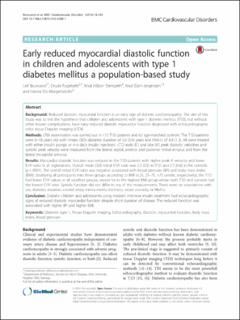| dc.contributor.author | Brunvand, Leif | |
| dc.contributor.author | Fugelseth, Drude | |
| dc.contributor.author | STENSÆTH, KNUT-HAAKON | |
| dc.contributor.author | Dahl-Jørgensen, Knut | |
| dc.contributor.author | MARGEIRSDOTTIR, HANNA DIS | |
| dc.date.accessioned | 2020-03-23T07:36:11Z | |
| dc.date.available | 2020-03-23T07:36:11Z | |
| dc.date.created | 2016-07-08T10:41:33Z | |
| dc.date.issued | 2016 | |
| dc.identifier.citation | BMC Cardiovascular Disorders. 2016, 16 (103), . | en_US |
| dc.identifier.issn | 1471-2261 | |
| dc.identifier.uri | https://hdl.handle.net/11250/2647986 | |
| dc.description.abstract | Background
Reduced diastolic myocardial function is an early sign of diabetic cardiomyopathy. The aim of this study was to test the hypothesis that children and adolescents with type 1 diabetes mellitus (T1D), but without other known complications, have early reduced diastolic myocardial function diagnosed with echocardiographic color tissue Doppler imaging (cTDI).
Methods
cTDI examination was carried out in 173 T1D patients and 62 age-matched controls. The T1D-patients were 8–18 years old with (mean (SD)) diabetes duration of 5.6 (3.4) years and HbA1c of 8.4 (1.3). All were treated with either insulin pumps or 4–6 daily insulin injections. cTDI early (E’) and late (A’) peak diastolic velocities and systolic peak velocity were measured from the lateral, septal, anterior and posterior mitral annulus and from the lateral tricuspidal annulus.
Results
Myocardial diastolic function was reduced in the T1D-patients with higher peak A’-velocity and lower E’/A’-ratio in all registrations. Overall mean (SD) mitral E’/A’-ratio was 2.3 (0.5) in T1D and 2.7 (0.6) in the controls (p < 0001). The overall mitral E’/A’-ratio was negative associated with blood pressure (BP) and body mass index (BMI). Stratifying all participants into three groups according to BMI (<25, 25–75, >75 centile, respectively), the T1D had lower E’/A’-values in all stratified groups, except for in the highest BMI-group where both T1D and controls had the lowest E’/A’-ratio. Systolic function did not differ in any of the measurements. There were no associations with sex, diabetes duration, carotid artery intima-media-thickness, vessel elasticity or HbA1c.
Conclusion
Diabetic children and adolescents using modern intensive insulin treatment had echocardiographic signs of reduced diastolic myocardial function despite short duration of disease. The reduced function was associated with higher BP and higher BMI. | en_US |
| dc.language.iso | eng | en_US |
| dc.publisher | BMC (part of Springer Nature) | en_US |
| dc.rights | Navngivelse 4.0 Internasjonal | * |
| dc.rights.uri | http://creativecommons.org/licenses/by/4.0/deed.no | * |
| dc.title | Early reduced myocardial diastolic function in children and adolescents with type 1 diabetes mellitus a population-based study | en_US |
| dc.type | Peer reviewed | en_US |
| dc.type | Journal article | en_US |
| dc.description.version | publishedVersion | en_US |
| dc.source.pagenumber | 5 | en_US |
| dc.source.volume | 16 | en_US |
| dc.source.journal | BMC Cardiovascular Disorders | en_US |
| dc.source.issue | 103 | en_US |
| dc.identifier.doi | 10.1186/s12872-016-0288-1 | |
| dc.identifier.cristin | 1366925 | |
| dc.description.localcode | © 2016 The Author(s). Open Access This article is distributed under the terms of the Creative Commons Attribution 4.0 International License (http://creativecommons.org/licenses/by/4.0/) | en_US |
| cristin.ispublished | true | |
| cristin.fulltext | original | |
| cristin.qualitycode | 1 | |

